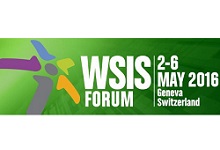Emerging ICT trends: Open source technologies for sustainable development
5 May 2016 15:00h
Event report
[Read more session reports and live updates from the WSIS Forum 2016.]
Mr Muhamed Ba (Head of Innovation Division BDT, ITU) pointed out that the aim of this series of sessions on innovation development is to look at how things work together as a system. He added that in today’s open economy, resources and talents move fast on a global level. This new business model affects the software industry, and shows us that companies can no longer compete using closed technology.
Mr Leon Strous (President, International Federation for Information Processing (IFIP)) introduced us to the work of the IFIP, a federation run by volunteers that hosts 120 working groups. In his words, open source can be described as something developed in a collaborative public manner with a specific business model that differs from the traditional. He added that standardisation is one of the issues to be discussed further. Strous pointed out some of the issues that can arise, such as: research funding – should it be private or public, collaboration of communities involved, and rivalry between companies. On the side of economic interest he added that this field is definitely attracting funds and companies can grow. He gave an example of the open source company RedHat, now valued at $4 billion.
Mr Brett Makens (Internet Governance and Telecommunications Officer, USA) graded recent trends in government to implement open source as part of national policies. He reminded us of efforts by the US government towards access to a custom software code developed for the Federal government. The Federal Source Code Policy is soon to be implemented. This policy will require covered agencies to release at least 20% of their newly developed custom code. He also pointed out the success of the US global development lab, developed as a private-public partnership.
Prof. Lichia Saner-Yiu, (Education Director and President, Centre for Socio-Eco-Nomic Development (CSEND)) addressed the benefits for civil society of open technologies. We usually think about the business utilisation, but there are also environmental and social justice angles. Now, when nations stand together on a road towards the sustainable development goals (SDGs) they need open technology to feed the information about the level of SDG completion. Continuous correction needs to come from the bottom and the community needs to be engaged in the decision-making process. Saner-Yui added that governments need to think about how to implement e-literacy in the daily routine. They need to encourage users to use simple tools and services and start participating.
Ms Myriam Ayass (Legal Adviser, Knowledge Transfer Group, CERN) clarified the CERN open software program and added that CERN is about collaboration and that sharing is deeply rooted in the system. She described the open hardware as a ‘distributed design’ and explained that even after initial hesitations about business implementation, they can now see a significant growth in development. CERN demands open source copyleft licences in order to keep track of dissemination. The real challenge is in getting sufficient help from the open software society in order to power these open hardware systems. This is surely a way of empowering users.
In a reaction from audience we heard about the Estonian case of good practice in open software utilisation. Two main things from this case are the importance of e-society to lean on an online service and use it. This way demand is created for more development in the field. Another is avoiding one big database by layering data with the X-road system.
The audience asked what to do to increase the awareness about open software. How can we implement capacity building in helping end users? Are there efforts to standardise procedures and streamline processes?
Strous added that educating and informing is the best way to share awareness. We need to inform those who can benefit, explain what it is and how it works. In the case of an overarching policy, he thinks that it is better to have many small and national policies.
Ayass added that there is a cost in terms of time that needs to be counted when filing forms for these open innovations, so policies can help in that sense. Open data, open software, and open access need to continue to grow together in order to give the industry and society a boost.
Makens emphasised the good practice of sharing good products with the public, and letting people improve and build on them.
Saner-Yiu pointed out that the major threshold is about capability, and urged a partnership to be put in place to add data to overview the timeframe and inputs of the SDGs and over all development.
At the conclusion, Ba added that success stories can be a way forward to increase awareness. He pointed out that the Digital Dividend is missing for those connected today, and technology is not the root of our problems. In a network economy, innovation comes from everywhere. We need to co-create our future together, by sharing best practices and learning from our mistakes we move forward.
by Arvin Kamberi
Related topics
Related event

